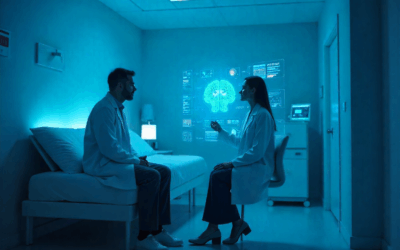Quick Summary
- AI medical scribes for primary care cut charting time by up to 55%.
- AI-powered triage tools streamline patient intake, reducing wait times.
- AI diagnostic imaging review supports faster and more accurate reads.
- AI clinical decision support systems (CDSS) help primary care providers reduce diagnostic errors.
- Designed to save clinicians 2+ hours daily, lower burnout, and improve patient satisfaction.

Why Primary Care Needs AI Tools in 2025
Primary care practitioners are often the first point of contact for patients, managing everything from preventive care to chronic illness. Yet, they face growing demands: increased patient loads, documentation burdens, and rising expectations for speed and accuracy. In 2025, AI tools became essential in primary care, not just optional add-ons.
According to the HIMSS 2025 Survey, 47% of U.S. primary care practices are already adopting at least one AI-powered solution. The goal: improve documentation, enhance accuracy, and free up physicians to focus on patients.
1. AI Medical Scribes for Primary Care
Among the most impactful tools for primary care today are AI medical scribes. These systems capture clinical conversations in real time, structure them into SOAP notes, and make them immediately available for review.
Benefits for Primary Care Providers
- Charting time reduced by 50–55%
- Error reduction in prescriptions and notes by up to 30%
- Available in multiple languages — English, Spanish, French, Portuguese, Italian
- Compatible with major EHRs or export-ready for copy/paste
For example, Dorascribe allows primary care doctors to record, transcribe, and format notes automatically, saving hours each week. See more specialty-specific examples on our Emergency Medicine and Physiotherapy pages.
2. AI-Powered Triage & Symptom Checkers
AI-driven triage systems are designed to guide patients through pre-visit questionnaires or digital intake flows, flagging urgent cases and reducing administrative work. A simple digital intake form before the visit can provide immense value.
Key Features
- Natural language symptom checkers
- Risk stratification (urgent vs routine)
- Automated intake notes synced with the provider’s EHR
Impact:
- Cuts waiting room delays by up to 20 minutes per patient
- Improves patient satisfaction with smoother onboarding
- Helps physicians start visits with structured histories

3. AI Diagnostic Imaging Review
Primary care often involves referrals and review of imaging studies such as X-rays, ultrasounds, and CT scans. AI imaging analysis tools provide a second set of eyes, helping PCPs detect abnormalities faster.
How It Helps
- Highlights suspicious regions on scans
- Detects early signs of conditions like pneumonia or fractures
- Reduces missed findings by 15–25% (JAMA Radiology 2024)
For busy clinics, this means faster decision-making and more confident referrals.
4. AI Clinical Decision Support Systems (CDSS)
Decision support has advanced from simple alerts to full AI-driven guidance. CDSS tools now integrate lab data, imaging, and patient history to suggest next steps.
Features in 2025
- Alerts for potential drug interactions
- Evidence-based recommendations for chronic disease management
- Predictive analytics for hospital admission risks
Example: A CDSS might recommend medication adjustments for a diabetic patient while flagging abnormal lab results for immediate attention.

How These Tools Work Together
While each tool is valuable on its own, the true power comes when combined:
- An AI scribe documents the patient visit.
- An AI triage tool provides pre-visit context.
- AI imaging review supports quicker interpretation of results.
- AI CDSS ensures the right care plan is followed.
Together, these systems save time, reduce errors, and create a safer, more efficient patient journey.
Compliance & Data Security
Primary care practices must ensure all AI tools meet compliance standards:
- HIPAA / PHIPA / GDPR compliance
- EU AI Act (2025) — both medical scribes and triage tools are classified as low-risk under current guidance
- End-to-end encryption (AES‑256, TLS 1.3)
- Vendor-signed Business Associate Agreements (BAAs)
For more detail, see our post on Patient Privacy & Data Security.
Implementation Checklist: Getting Started with AI Tools in Primary Care
1–2: Identify biggest workflow pain points (documentation, intake, imaging).
3–4: Pilot AI scribe like Dorascribe with shadow mode enabled.
5: Integrate AI triage tool with EHR scheduling system.
6: Enable imaging review + CDSS modules.
7: Evaluate results: aim for ≥ 40% documentation time savings + improved throughput.
FAQ: AI Tools in Primary Care
Q1: Can AI tools replace a primary care physician?
No. These tools assist with documentation and decision support but the physician remains in control of care decisions.
Q2: How accurate are AI scribes in noisy environments?
Platforms like Dorascribe reach 92% accuracy in multi-speaker settings, including family medicine practices.
Q3: Are AI triage tools safe for patients?
Yes, when properly configured they only support—not replace—physician judgment.
Q4: How much time can AI save per week?
Most practices report saving 10–15 hours per provider per week on documentation and admin.
Final Thoughts
Primary care physicians face heavy workloads and increasing pressure to deliver accurate, patient-centered care. AI tools in primary care are no longer experimental—they are practical, proven, and increasingly expected by patients.
From AI medical scribes like Dorascribe to triage systems, diagnostic imaging tools, and CDSS platforms, clinics that embrace these solutions are seeing measurable gains in efficiency, accuracy, and physician well-being.
👉 Ready to reduce documentation burden and improve your practice? Start your free trial of Dorascribe today.




